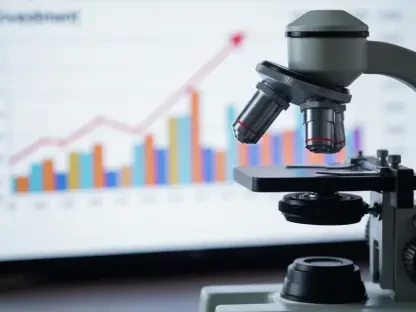Overview of Big Data in Women’s Health Research
Imagine a world where a chronic condition affecting millions of women globally, often dismissed as mere menstrual pain, reveals connections to unexpected health issues like asthma or certain cancers through the power of data. Endometriosis, a debilitating disorder where tissue similar to the uterine lining grows outside the uterus, impacts roughly 10% of women worldwide, causing severe pain and infertility. In the current landscape of medical research, big data has emerged as a game-changer, offering unprecedented insights into complex diseases by analyzing vast electronic health records (EHRs). This industry report delves into how big data is reshaping the understanding of endometriosis, highlighting a pivotal study from the University of California San Francisco (UCSF) that uncovers its links to diverse health conditions. The exploration of such connections signals a transformative shift in healthcare approaches, promising more comprehensive care for affected individuals.
The healthcare industry today stands at a crossroads, with technological advancements enabling researchers to process enormous datasets that were once unmanageable. Big data analytics, supported by computational algorithms, allows for the detection of patterns and correlations that traditional methods might overlook. In the realm of women’s health, where conditions like endometriosis have long been understudied, this capability is particularly vital. The focus on EHRs from multiple health centers provides a robust foundation for identifying systemic impacts, pushing the boundaries of how medical professionals view and treat chronic disorders.
Detailed Analysis of Big Data’s Impact on Endometriosis Research
Unveiling Multisystem Connections
A groundbreaking study conducted across six UC health centers has revealed over 600 correlations between endometriosis and a range of other diseases, challenging the long-held perception of it as solely a reproductive issue. The findings span expected associations, such as infertility and autoimmune disorders, to surprising links with conditions like migraines, asthma, certain cancers, and even eye diseases. This broad spectrum of connections suggests that the disorder exerts a multisystem influence, necessitating a reevaluation of clinical perspectives to encompass overall health impacts rather than isolated symptoms.
The methodology behind these discoveries involved comparing the health histories of patients diagnosed with endometriosis against those without the condition, using sophisticated computational tools to detect recurring patterns. Such an approach highlights the strength of big data in uncovering hidden relationships that could inform cross-disciplinary treatment strategies. For instance, the correlation with migraines opens the possibility of repurposing headache medications for managing chronic pain associated with endometriosis, illustrating practical applications of these insights.
Looking at industry trends, the ability to identify such diverse correlations underscores a growing reliance on data-driven research to address complex health challenges. The robustness of results across multiple institutions enhances the credibility and generalizability of findings, setting a precedent for similar studies in other chronic conditions. Forecasts suggest that over the next few years, from 2025 to 2027, the integration of big data in medical research will likely accelerate, potentially leading to earlier diagnoses and more tailored interventions for patients with multifaceted disorders.
Challenges and Limitations in Data-Driven Research
Despite the promising outcomes, leveraging big data for studying endometriosis comes with significant hurdles that the industry must navigate. Ensuring data privacy remains a paramount concern, as EHRs contain sensitive patient information that must be de-identified to prevent breaches. Additionally, managing the sheer volume of data requires advanced technological infrastructure, which may not be uniformly available across all healthcare settings, posing a barrier to widespread adoption.
Another critical challenge lies in distinguishing correlation from causation within the identified links. While big data excels at spotting patterns, it cannot inherently confirm that endometriosis directly causes or is caused by associated conditions like asthma or migraines. This limitation necessitates further clinical studies to validate findings, a process that could span years and require substantial funding and interdisciplinary collaboration to bridge the gap between data insights and actionable medical practices.
Industry forecasts indicate that overcoming these obstacles will involve strategic investments in data security and clinician training to interpret big data outputs effectively. The integration of such insights into routine healthcare also faces resistance due to varying levels of technological readiness among providers. Collaborative efforts between tech developers, medical professionals, and policymakers will be essential to standardize practices and ensure that the benefits of big data research translate into tangible improvements in patient care.
Ethical and Regulatory Landscape
The ethical dimensions of utilizing EHRs in medical research form a crucial aspect of industry discourse, particularly concerning patient consent and data protection. Compliance with regulations such as the Health Insurance Portability and Accountability Act (HIPAA) is non-negotiable, shaping how studies are designed and data is shared. Researchers must prioritize transparency in how patient information is used, ensuring that individuals are informed about the scope and purpose of such analyses.
Regulatory frameworks also influence the broader adoption of big data in healthcare, often dictating the pace at which innovations are implemented. Striking a balance between protecting patient rights and fostering research progress is a persistent challenge for the industry. Clear communication of findings to the public is equally important to prevent misinterpretation or unnecessary alarm among those affected by conditions like endometriosis, maintaining trust in data-driven medical advancements.
Trends in the regulatory space suggest a move toward stricter guidelines as data usage expands, with potential updates to existing laws to address emerging technologies. Industry stakeholders are increasingly advocating for standardized ethical protocols to facilitate international collaboration while safeguarding patient interests. This evolving landscape will likely shape the trajectory of big data applications in health research for years to come, impacting how quickly new discoveries can be applied clinically.
Future Prospects and Innovations
Looking ahead, the future of endometriosis research appears poised for significant advancements through big data and related technologies. The correlations identified in the UCSF study pave the way for clinical trials aimed at validating these links and developing targeted treatments that address the multisystem nature of the condition. Such efforts could redefine therapeutic approaches, moving toward personalized medicine based on individual health profiles.
Emerging tools like artificial intelligence and machine learning are expected to further refine big data analysis, enhancing diagnostic precision and predictive modeling for endometriosis and beyond. These technologies hold the potential to streamline the identification of at-risk patients, reducing diagnostic delays that often span years. Industry projections highlight a surge in investments for such innovations, with a focus on integrating these tools into everyday clinical practice by the end of the decade.
Global trends also point to increased funding for women’s health research, coupled with international partnerships to pool data and expertise. This collaborative spirit could accelerate progress in understanding complex conditions, ensuring that findings are applicable across diverse populations. Patient-centered care remains a priority, with future studies likely to emphasize individualized treatment plans that account for the varied manifestations of endometriosis, setting a new standard for comprehensive healthcare delivery.
Reflections and Path Forward
Reflecting on the insights gathered, the transformative role of big data in revealing endometriosis as a multisystem disorder stands out as a pivotal shift in medical understanding. The extensive correlations unearthed through EHR analysis across multiple health centers mark a significant departure from traditional views, broadening the scope of clinical considerations. This exploration illuminates the profound burden of the condition on affected individuals, spanning physical, emotional, and social dimensions.
Moving forward, actionable steps emerge as critical to harnessing these findings for real-world impact. Prioritizing clinical trials to confirm the identified links offers a concrete path to developing innovative treatments. Simultaneously, investing in advanced data security measures and training for healthcare providers ensures that big data tools can be seamlessly integrated into practice. These efforts, combined with global collaboration and a commitment to patient-centered research, promise to elevate the standard of care for endometriosis, ultimately enhancing the quality of life for millions worldwide.









